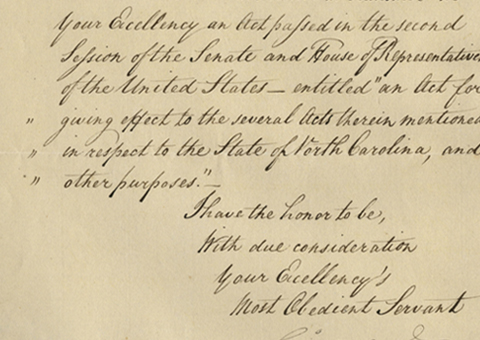Marie Curie Needs Researchers Competent in Radioactivity at Her New “Laboratoire Curie” in Paris


In a letter speaking on behalf of a key researcher in charge of preparation of radioactive material, she writes twice the word ‘radioactive,’ a word she created.
In 1891, Marie Curie left Poland for Paris, where she studied Physics and Mathematical Sciences at the Sorbonne and met her husband, Pierre. She arrived in France during momentous times. Wilhelm Conrad Roentgen had discovered x-rays in 1895, and in 1896 Antoine Henri Becquerel discovered that the element uranium gives off similar...
In 1891, Marie Curie left Poland for Paris, where she studied Physics and Mathematical Sciences at the Sorbonne and met her husband, Pierre. She arrived in France during momentous times. Wilhelm Conrad Roentgen had discovered x-rays in 1895, and in 1896 Antoine Henri Becquerel discovered that the element uranium gives off similar invisible radiations. Curie began studying uranium emissions and realized that unknown elements, even more radioactive than uranium, must be present. She was the first to use the term “radioactive,” coining the phrase. In 1898 the Curies announced their discovery of two new elements: radium and polonium (the latter named by Marie in honor of her homeland, Poland). They shared the 1903 Nobel Prize in Physics with Becquerel for the discovery of radioactive elements. Marie Curie was the first female recipient of a Nobel Prize, and in 1911, became the first woman to win a second. She earned, on her own, the award in Chemistry for isolating pure radium.
This success sparked a career of ever-expanding research. In 1914, the University of Paris built Curie the Institut du Radium, where she would finally have sufficient laboratory space to expand her research on radioactive materials. This would be the base of her research. In the late 1920s, she began work to expand and open a large annex to her Institute, an annex that would allow for the chemical treatment of radioactive materials, materials she was bringing in from around the world. Located outside Paris in Arcueil, this would also be a focal point for the accumulation of radioactive materials needed to continue her studies of polonium and radium. She had long hoped for this annex to broaden the scope of her research and provide a ready stable of elements, and she poured great energy into its establishment and proper functioning, even as her health declined (a by-product of a life spent around radioactivity).
This new institute was the culmination of her life’s work in France. Running this new facility, however, took researchers competent in a field where few were qualified. Alexis Jakimach was one such person. A Czech chemist, he had come to France in 1930 to work under Curie and, like her, to study at the Sorbonne. He was soon placed in charge of the preparation of radioactive materials at the Arcueil annex, materials which were prepared by Jakimach and then sent to the main campus at the Radium Institute in Paris. In 1932 the annex formally opened and Jakimach would play a pivotal role. Jakimach was a Czech citizen and needed her support to obtain the permit necessary for him to remain in France. And with the relatively new field of radiation lacking a healthy stable of researchers, she ensured that would happen.
Typed Letter Signed, on “Institut du Radium, Laboratoire Curie” letterehead, Paris, November 10, 1931, to the police agency handling foreign permits. “M. Alexis Jakimach has prepared a scientific doctoral thesis at the Laboratory of M. le Pr. Auger at the University of Sciences in Paris. At the same time, he was working with me in my laboratory in order to acquaint himself with the technique of radioactivity. During the course of the scholastic year 1930-1931, he undertook a number of experiments aimed at the preparation of radioactive material. For the scholastic year 1931-1932 he has been charged with continuing his work as a paid chemist for my laboratory. Given the small number of people specializing in this field, it would be presently impossible to replace M. Jakimach with another chemist having the same competence, without damage to the work in my laboratory. It would therefore be preferable that M. Jakimach continue to work in my laboratory, something he cannot do in any other capacity than paid chemist. Le Directeur du Laboratoire, M. Curie.” The letter has also been approved by M. Magnan, the Superintendent of the Parisian Police. The approved letter was handed back to Jakimach to carry with him, and he retained it all his life, which included a move to the United States. When his widow died she left it to a family friend, from whom we recently obtained it. It has never before been offered for sale.
Letters signed by Curie mentioning radioactivity and dealing with her research are uncommon, just a small handful having been recorded in public records over the last three decades.

Frame, Display, Preserve
Each frame is custom constructed, using only proper museum archival materials. This includes:The finest frames, tailored to match the document you have chosen. These can period style, antiqued, gilded, wood, etc. Fabric mats, including silk and satin, as well as museum mat board with hand painted bevels. Attachment of the document to the matting to ensure its protection. This "hinging" is done according to archival standards. Protective "glass," or Tru Vue Optium Acrylic glazing, which is shatter resistant, 99% UV protective, and anti-reflective. You benefit from our decades of experience in designing and creating beautiful, compelling, and protective framed historical documents.
Learn more about our Framing Services







































































































